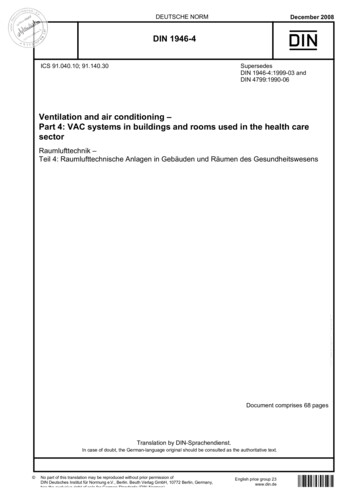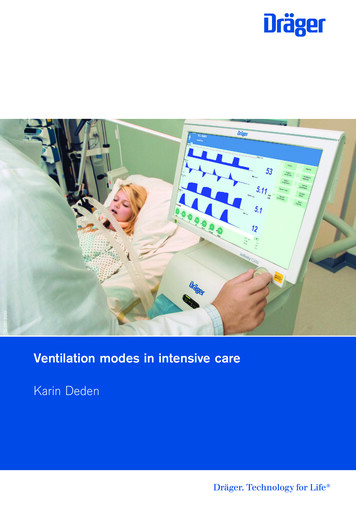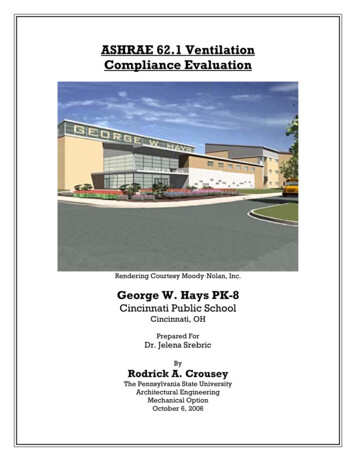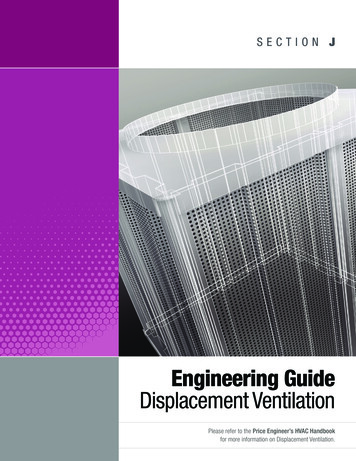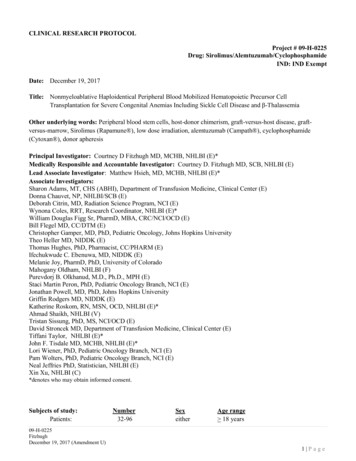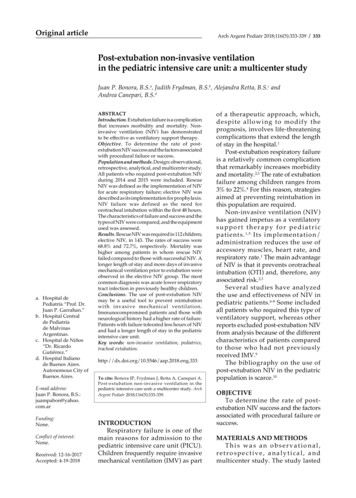
Transcription
Original articleArch Argent Pediatr 2018;116(5):333-339 / 333Post-extubation non-invasive ventilationin the pediatric intensive care unit: a multicenter studyJuan P. Bonora, B.S.a, Judith Frydman, B.S.b, Alejandra Retta, B.S.c andAndrea Canepari, B.S.da. Hospital dePediatría “Prof. Dr.Juan P. Garrahan.”b. Hospital Centralde Pediatríade MalvinasArgentinas.c. Hospital de Niños“Dr. RicardoGutiérrez.”d. Hospital Italianode Buenos Aires.Autonomous City ofBuenos Aires.E-mail address:Juan P. Bonora, B.S.:juampabon@yahoo.com.arFunding:None.Conflict of interest:None.Received: 12-16-2017Accepted: 4-19-2018ABSTRACTIntroduction. Extubation failure is a complicationthat increases morbidity and mortality. Noninvasive ventilation (NIV) has demonstratedto be effective as ventilatory support therapy.Objective. To determine the rate of postextubation NIV success and the factors associatedwith procedural failure or success.Population and methods. Design: observational,retrospective, analytical, and multicenter study.All patients who required post-extubation NIVduring 2014 and 2015 were included. RescueNIV was defined as the implementation of NIVfor acute respiratory failure; elective NIV wasdescribed as its implementation for prophylaxis.NIV failure was defined as the need fororotracheal intubation within the first 48 hours.The characteristics of failure and success and thetypes of NIV were compared, and the equipmentused was assessed.Results. Rescue NIV was required in 112 children;elective NIV, in 143. The rates of success were68.8% and 72.7%, respectively. Mortality washigher among patients in whom rescue NIVfailed compared to those with successful NIV. Alonger length of stay and more days of invasivemechanical ventilation prior to extubation wereobserved in the elective NIV group. The mostcommon diagnosis was acute lower respiratorytract infection in previously healthy children.Conclusions. The use of post-extubation NIVmay be a useful tool to prevent reintubationwith invasive mechanical ventilation.Immunocompromised patients and those withneurological history had a higher rate of failure.Patients with failure tolerated less hours of NIVand had a longer length of stay in the pediatricintensive care unit.Key words: non-invasive ventilation, pediatrics,tracheal 333To cite: Bonora JP, Frydman J, Retta A, Canepari A.Post-extubation non-invasive ventilation in thepediatric intensive care unit: a multicenter study. ArchArgent Pediatr 2018;116(5):333-339.INTRODUCTIONRespiratory failure is one of themain reasons for admission to thepediatric intensive care unit (PICU).Children frequently require invasivemechanical ventilation (IMV) as partof a therapeutic approach, which,despite allowing to modify theprognosis, involves life-threateningcomplications that extend the lengthof stay in the hospital.1Post-extubation respiratory failureis a relatively common complicationthat remarkably increases morbidityand mortality.2,3 The rate of extubationfailure among children ranges from3% to 22%.4 For this reason, strategiesaimed at preventing reintubation inthis population are required.Non-invasive ventilation (NIV)has gained impetus as a ventilatorysupport therapy for pediatricpatients. 1,5 Its implementation/administration reduces the use ofaccessory muscles, heart rate, andrespiratory rate.1 The main advantageof NIV is that it prevents orotrachealintubation (OTI) and, therefore, anyassociated risk.2,3Several studies have analyzedthe use and effectiveness of NIV inpediatric patients. 6-8 Some includedall patients who required this type ofventilatory support, whereas otherreports excluded post-extubation NIVfrom analysis because of the differentcharacteristics of patients comparedto those who had not previouslyreceived IMV.9The bibliography on the use ofpost-extubation NIV in the pediatricpopulation is scarce.10OBJECTIVETo determine the rate of postextubation NIV success and the factorsassociated with procedural failure orsuccess.MATERIALS AND METHODSThis was an observational,retrospective, analytical, andmulticenter study. The study lasted
334 / Arch Argent Pediatr 2018;116(5):333-339 / Original article2 years. All patients aged 1 month to 18 yearsold who required post-extubation NIV betweenJanuary 1st, 2014 and December 31st, 2015 in fourmultipurpose PICUs of tertiary care facilities wereincluded.Patients were extubated after a spontaneousbreathing trial in accordance with the criteria inplace at each facility.Rescue NIV (rNIV) was defined as theimplementation of NIV for acute respiratoryfailure within the first 48 hours after extubation.Respiratory failure was defined as type I ortype II respiratory failure and/or upper airwayobstruction.11Elective NIV (eNIV) was defined as theimplementation of NIV immediately afterextubation for prophylaxis due to a potentialrisk for failure. eNIV was implemented inpatients with prolonged IMV,12,13 prior extubationfailures, weakness caused by intrinsic muscledisease, weakness of the inspiratory musclesevidenced by a reduced diaphragmatic mobilityin the ultrasound or maximal inspiratory pressurebelow -20 cmH 2 O, heart disease or relevantrespiratory history.The physical therapists working at eachPICU recorded data every day using cards andcollecting information from the medical records.Interfaces included full-face masks, helmets,oronasal masks, nasal masks, and nasal cannulae.The interface choice depended on the patient’sage and/or availability; full-face and oronasalmasks were prioritized for acute respiratoryfailure patients, whereas nasal masks werereserved for chronic conditions.Microprocessor-controlled ventilators withNIV-dedicated software, intermediate ventilators,and continuous flow bi-level ventilators wereused.14 The ventilator was selected depending onits availability at each PICU.Ventilation modes included pressuresupport ventilation, pressure-assist/controlventilation, bi-level pressure support deliveredin the spontaneous or spontaneous/timed mode,and continuous positive airway pressure. Theventilation mode was chosen based on thepatient’s condition in an attempt to achieve thebest patient-ventilator synchrony. The prevailingmode during NIV requirement was taken intoconsideration.The ventilation strategy consisted in usingpositive end-expiratory pressure (PEEP) andfraction of inspired oxygen (FiO2) levels necessaryto achieve an oxygen saturation above 92%and the assistance pressure necessary to reacha tidal volume between 8 and 10 mL/kg. Oncethe therapeutic target is achieved, ventilatoryparameters were progressively reduced, withrotation of the interface or periodic equipmentdisconnection, depending on the patient’sstability in terms of clinical, blood gases, andradiological parameters, until ventilatory supportwas removed completely.The following outcome measures wereconsidered: age, weight, sex, severity score(pediatric index of mortality 2, PIM2), length ofstay in the PICU (days), reason for admissionto the PICU (cardiac, respiratory, neurological,postoperative period after non-cardiovascularsurgery, septic shock, external injury, other),diagnosis (trauma, acute lower respiratory tractinfection [ALRTI], ALRTI in a patient withsequelae [from prior comorbidities], postoperativeperiod of a general surgery, neurosurgery,neuromuscular condition, immunocompromise,acute neurological event, non-respiratoryinfection, heart failure, other), reason forimplementation of NIV (respiratory distress,hypoventilation, upper airway obstruction,risk for extubation failure), history (sequelaeof lung disease, heart disease, neurologicalinjury, immunocompromise, airway, digestiveor liver malformations, more than one factorcorresponding to the history).The different comorbidities present in thepatients were classified based on the historyoutcome measure, considering the classificationmentioned by Feudtner et al., 15 which codedpatients based on the type of chronic disease.The following parameters were monitored:partial pressure of oxygen (PO2), saturation andpartial pressure of carbon dioxide (PCO2) prior toNIV, and delta of pressure, PEEP, FiO2 or liters ofoxygen (O2) at NIV initiation.To measure technique effectiveness, thefollowing outcome measures were recorded:NIV type (rescue, elective), NIV result (success,failure), hours of NIV, days of IMV prior toextubation, and mortality. NIV failure wasdefined as the need for endotracheal intubationwithin the first 48 hours in accordance with thecriteria in place at each PICU. Depending onthe time of failure, initial failure was definedas the need for reintubation within the firsthour; early failure, as the need for reintubationfrom 1 to 12 hours; and late failure ( 12 hours),as the need for reintubation in any otheroccasion. 5 The reasons for failure included
Post-extubation non-invasive ventilation in the pediatric intensive care unit: a multicenter study / 335progression of respiratory distress, hypoxemia,impaired sensorium, upper airway obstruction,hemodynamic alterations, and inability to protectthe airway.Statistical analysisThe sample was described using the medianas a measure of central tendency and the 25-75interquartile range as a measure of dispersion fornumerical outcome measures; whereas, absolutecount and percentage were used for categoricaloutcome measures. Numerical outcome measureswere compared using the Mann-Whitney test andcategorical outcome measures, using the χ² test.A p value 0.05 was considered statisticallysignificant. Data were analyzed using the IBMSPSS Macintosh software, version 20.0 (IBMCorp., Armonk, NY, USA).RESULTSA total of 255 patients who received postextubation NIV were included. Figure 1 shows theflow chart of included patients.The clinical and demographic characteristicsof patients are described in Table 1.The success of eNIV reached 72.7%. Acomparison of relevant clinical outcome measuresbetween patients who experienced eNIV failureor success is shown in Table 2.The success of rNIV reached 68.8%. Table 3describes the differences between patients whoexperienced rNIV failure or success.The full-face mask was the most commonlyused interface (106 patients, 41.6%), followed bythe oronasal mask (28.6%), nasal cannula (16%),nasal mask (8.6%), nasal pillow mask (4.3%), andhelmet (0.8%).Also, 69% of ventilators were microprocessorcontrolled ventilators for intensive care withsoftware to account for leakages; 29% wereintermediate ventilators, and only 2% werecontinuous flow bi-level ventilators.Ventilation modes included pressure support(70.5%), pressure assist-control (26.1%), bi-levelpressure support delivered in the spontaneous/timed mode (1.7%), and continuous positiveairway pressure (1.7%).The total analysis of failures revealed that 60%corresponded to late failure; 20%, to early failure;and 20%, to initial failure. The causes of failurein the eNIV and rNIV groups were progressionof respiratory distress (38.5% and 19.7%), upperairway obstruction (15.4% and 36.3%), inability toprotect the airway (15.4% and 13.3%), impairedsensorium (11.5% and 13.3%), hypoxemia(11.5% and 6.7%), and hemodynamic alterations(7.7% and 10.7%, respectively). Patients withneurological history and immunocompromisedFigure 1. Flow chart of patientsNIV: non-invasive ventilation; IMV: invasive mechanical ventilation.
336 / Arch Argent Pediatr 2018;116(5):333-339 / Original articlepatients had a higher rate of failure (n 19; 41.3%and n 13; 39.4%, respectively) compared to thosewith other comorbidities, for whom the rateof failure was similar to that of the populationwithout prior sequelae (n 19; 21.7%) (p 0.007).The overall mortality of patients with postextubation NIV was 4.4% (11 patients). Eightdeaths (5.6%) were recorded in the eNIV group;of these, 4 corresponded to those with successfuleNIV, 1 with initial failure, and 3 with late failure.Only 3 patients died in the rNIV group: 1 caseof initial failure, 1 case of early failure, and 1caseof late failure.DISCUSSIONIn the studied population, it was possibleto avoid reimplementation of IMV in 71% ofpatients. Patients’ median age, weight, andmortality score were 15 months, 15 kg, and 4.8,respectively. Besides, 48.3% of patients weregirls; the most common diagnosis was respiratoryinfection in previously healthy children. Nosignificant differences were observed betweenfailure and success cases in terms of any of theseoutcome measures.eNIV accounted for 56% of studied children.Gupta et al. allocated patients to receive eNIV ifTable 1. Demographic outcome measuresOutcome measureAge (months old), median (Q2-Q3)Weight (kg), median (Q2-Q3)Sex, n (%)PIM2, median (Q2-Q3)Diagnosis, n (%):TraumaALRTI in previously healthy childALRTI in a patient with sequelaePost-operative period of a general surgeryNeurosurgeryNeuromuscular conditionImmunocompromiseAcute neurological eventNon-respiratory infectionHeart failureOtherReason for admission to the PICU, n (%):CardiacRespiratoryNeurologicalPost-operative period afternon-cardiovascular surgerySeptic shockExternal injuryOtherHistory, n (%):Heart diseaseSequelae of lung diseaseNeurological injuryImmunocompromiseAirway, liver, digestivemalformationMore than one factorcorresponding to historyNo historyReason for implementation of NIV, n (%):Respiratory distressHypoventilationUpper airway obstructionRisk for extubation failurePost-extubation NIVn 255Rescue NIVn 112Elective NIVn 14315 (4-72)15 (7-26)122 (48,4%) fem.4,8 (1,52-10,6)21 (4-81)15 (7.5-25)59 (52,3%) fem.4,65 (1,5-10)12 (4-66)12,5 (6,75-30)65 (45,4%) fem.5,6 (1,54-10.8)9 (3.5%)70 (27.5%)47 (18.4%)41 (16.1%)9 (3.5%)9 (3.5%)13 (5.1%)11 (4.3%)24 (9.4%)3 (1.2%)19 (7.5%)7 (6.3%)27 (24.1%)14 (12.5%)19 (17%)8 (7.1%)2 (1.8%)6 (5.4%)5 (4.5%)13 (11.6%)11 (9.8%)2 (1.4%)43 (30.1%)33 (23.1%)22 (15.4%)1 (0.7%)7 (4.9%)7 (4.9%)6 (4.2%)11 (7.7%)3 (2.1%)8 (5.6%)10 (3.9%)114 (44.7%)14 (5.5%)3 (2.7%)40 (35.7%)8 (7.1%)7 (4.9%)74 (51.7%)6 (4.2%)52 (20.4%)39 (15.3%)12 (4.7%)14 (5.5%)28 (25%)17 (15.2%)10 (8.9%)6 (5.4%)24 (16.8%)22 (15.4%)2 (1.4%)8 (5.6%)17 (6.7%)25 (9.9%)46 (18.3%)33 (13.1%)4 (3.6%)12 (10.9%)21 (19.1%)14 (12.7%)13 (9.2%)13 (9.2%)25 (17.6%)19 (13.4%)29 (11.5%)15 (13.6%)14 (9.9%)16 (5.2%)89 (35.3%)5 (4.5%)41 (37.3%)8 (5.6%)51 (35.9%)75 (28.2%)19 (7.5%)24 (9.4%)143 (54.9%)72 (64.3%)16 (14.3%)24 (21.4%)-143 (100%)Q2-Q3: 25%-75% quartile; fem.: female; ALRTI: acute lower respiratory tract infection; PICU: pediatric intensive care unit;PIM2: severity score.
Post-extubation non-invasive ventilation in the pediatric intensive care unit: a multicenter study / 337they were at a high risk for extubation failure andif they were weaning from IMV, and achieveda success rate of 74%.16 In addition, James et al.reached a 90% success rate with eNIV in childrenwho were in the immediate postoperativeperiod.17 In our study, the success of eNIV was72.7%, which was similar to that observed incomparable studies. 9,18 A direct associationwas observed between the hours of NIV andtherapeutic success, and a reverse association wasnoted between the length of stay in the PICU andNIV success. This evidences that patients withsuccessful NIV remained more hours in NIV,but had a shorter stay in the PICU. Although webelieve that, in our study, some children in thisgroup would have possibly avoided OTI withouteNIV, the potential side effects of this therapyappear to be minimal.rNIV accounted for 44% of cases. As inthe study by Gupta et al., 16 our results showan association between a reduced mortalityand ventilatory support success. In addition,Mayordomo-Colunga et al. observed a 50%success rate in their pilot study.9 In this group,the rate of success was 68.8%, which seems logicalconsidering that conditions are different from theeNIV group that used the therapy as prophylaxis,whereas in the rNIV group patients had signs ofrespiratory failure. The bibliography on the use ofrNIV in the pediatric population is scarce. Studiesin the adult population have not been conclusivein relation to its use. Esteban et al. demonstrated,Table 2. Elective non-invasive ventilationOutcome measureAge (months old), median (Q2-Q3)Weight (kg), median (Q2-Q3)PIM2, median (Q2-Q3)Length of stay in the PICU (days), median (Q2-Q3)O2 saturation (%), median (Q2-Q3)PaO2 (mmHg), median (Q2-Q3) P (cmH2O), median (Q2-Q3)PCO2 (mmHg), median (Q2-Q3)PEEP (cmH2O), median (Q2-Q3)FiO2, median (Q2-Q3)Days of prior IMV, median (Q2-Q3)Hours of NIV, median (Q2-Q3)Mortality, n (%)History, n (%)Successful (n 104)12 (5-60)12 (7-27.5)4.5 (0.95-10.8)21 (15-28)99 (97-100)148 (120-183)9 (7-10)37 (31.2-42.3)5 (5-6)0.5 (0.4-0.6)10 (5-15)72 (35.2-120)4 (3.9%)62 (60.2%)Failed (n 39)15 (4-85)17 (5.75-36)7.4 (2.4-11.8)28 (17-45.5)98 (97-100)138 (104-167.2)10 (7.5-11)38.5 (33-46.5)6 (5-7)0.5 (0.4-0.6)10 (5.5-22)24 (20-66)4 (11%)30 (76.9%)p value0.850.290.140.0190.160.610.180.560.120.330.47 0.0010.10.062Q2-Q3: 25%-75% quartile; PaO2: partial pressure of oxygen in arterial blood; PCO2: partial pressure of carbon dioxide;PEEP: positive end expiratory pressure; P: Delta of pressure; FiO2: fraction of inspired oxygen;PICU: pediatric intensive care unit; NIV: non-invasive ventilation; O2: oxygen; PIM2: severity score.Table 3. Rescue non-invasive ventilationOutcome measureAge (months old), median (Q2-Q3)Weight (kg), median (Q2-Q3)PIM2, median (Q2-Q3)Length of stay in the PICU (days), median (Q2-Q3)O2 saturation (%), median (Q2-Q3)PaO2 (mmHg), median (Q2-Q3)PCO2 (mmHg), median (Q2-Q3) P (cmH2O), median (Q2-Q3)PEEP (cmH2O), median (Q2-Q3)FiO2, median (Q2-Q3)Days of prior IMV, median (Q2-Q3)Hours of NIV, median (Q2-Q3)Mortality, n (%)History, n (%)Successful (n 77)30 (4-84)15 (7.2-24.7)4.5 (1.8-10)15.5 (11-24.25)99 (97-100)122.7 (132.5-165.5)39.5 (33.7-44.1)10 (7-10)5 (5-6)0.5 (0.4-0.6)5 (2.5-10)66 (24-120)48 (62.3%)Failed (n 35)10 (3-60)14 (6.5-26)4.8 (1-9.7)22 (15-37)99 (95-100)101.5 (81.1-232.7)31.5 (29.2-37.5)10 (8-11)6 (5-7)0.6 (0.5-0.6)6 (3-9)24 (2-45)3 (8.6%)23 (69.7%)p value0.60.590.490.0050.60.20.080.20.150.20.33 0.0010.010.46Q2-Q3: 25%-75% quartile; PaO2: partial pressure of oxygen in arterial blood; PCO2: partial pressure of carbon dioxide;PEEP: positive end expiratory pressure; P: Delta of pressure; FiO2: fraction of inspired oxygen;PICU: pediatric intensive care unit; NIV: non-invasive ventilation; O2: oxygen; PIM2: severity score.
338 / Arch Argent Pediatr 2018;116(5):333-339 / Original articlein a multicenter study, a higher mortalityamong patients who required rNIV compared toconventional therapy, and attributed such effectto a delay in reintubation times.19 Keenan et al. didnot find differences between both groups in termsof the reintubation rate and mortality.20 Giraultet al. observed that rNIV was beneficial forpatients with hypercapnic ventilatory failure afterextubation.21 Dean Hess recommended cautionin the use of rNIV and to prevent reintubationdelays if no satisfactory response is observed inthe first hour of implementation.22In our study, 15% of patients who wereadmitted to the critical care unit required postextubation NIV. This is comparable to whathas been described by Wolfler et al. in a studywith 13 Italian intensive care units where thepercentage was similar.23The presence of a complex chronic diseaseseems to have an impact on the outcomes of NIVimplementation.15 In the studied population, 35%of patients had some type of prior comorbidity.Immunocompromised patients and thosewith neurological sequelae showed a higherpercentage of failures. Mayordomo-Colunga et al.described a higher rate of failure among patientswith neurological history and attributed it topharyngeal hypotonia and inability to protect theairway adequately.9The analysis of failures revealed that mostpatients had a late failure. It has been describedthat a delay in reintubation increases mortality, soa late failure may increase it.19,20 However, the lowmortality level observed in the studied populationprevented us from establishing an associationwith the types of failure.Interfaces and harnesses play a key role inNIV use. Since the introduction of the full-facemask for pediatric patients in Argentina, in 2013,there has been an increase in its demand, and, atpresent, it has become the preferred interface. Themask adjusts on the front, cheeks, and chin of theface, all areas where there is much subcutaneoustissue, and this has helped to reduce pressureulcers and improve patients’ comfort, especially,younger ones. Chacur et al. found that thefull-face mask was more comfortable than theoronasal mask for adult patients, allowing themto use it for more time, but the authors did notfind differences in the success-failure rates. 24Lemyze et al. managed to prevent intubationin adult patients with hypercapnic ventilatoryfailure who were receiving NIV for a prolongedtime or who had facial injuries when changingfrom an oronasal mask to the full-face mask.25Microprocessor-controlled ventilators are themost commonly used ones for NIV at the PICUs,which now include software to account forleakages. Faroux et al. compared, in a lab setting,the performance of 17 ventilators for NIV inpediatrics mimicking different clinical situationsand patient weights. They concluded that noventilator responded correctly to all simulationsettings and had trouble working in youngerchildren.26 The reduced respiratory effort, the highrespiratory rate, and leakages in pediatric patientsare a major technological challenge that needs tobe resolved by advances in ventilators.The retrospective nature of this study makesit more susceptible to biases and errors. Besides,since this is a multicenter study, there is noinformation on the management of each patient’sunderlying condition at each participating PICU.Other limitation of this study is that it did nothave a randomized, controlled design andlacked a control group with patients who didnot receive NIV to prevent reintubation. In thisregard, patients who received eNIV may havenot required any type of positive pressure, andthis may have affected the end results. Lastly,there is a semantic limitation because the authorsworked in four different hospitals, so each mayhave used different terms typical of each PICU torecord NIV events.CONCLUSIONSThe use of post-extubation NIV may be usefulto prevent the reimplementation of IMV. Themost common diagnosis was ALRTI in previouslyhealthy children. Immunocompromised patientsand those with neurological history had a higherrate of failure compared to those with othercomorbidities, for whom the rate of failure wassimilar to that of the population without priorsequelae. Patients with failure tolerated lesshours of NIV and had a longer length of stay inthe PICU. Further studies are required to confirmthe effectiveness of post-extubation NIV in thepediatric population, as well as the influenceof the different interfaces and ventilators on itsperformance. nREFERENCES1.2.3.Mayordomo-Colunga J, Medina A, Rey C, et al. Predictoresde éxito y de fracaso en la ventilación no invasiva en labronquiolitis aguda. An Pediatr (Barc) 2009; 70(1):34-9.Epstein SK, Ciubotaru RL, Wong JB. Effect of failedextubation on the outcome of mechanical ventilation. Chest1997; 112(1):186-92.Epstein SK, Nevins ML, Chung J. Effect of unplannedextubation on outcome of mechanical ventilation. Am JRespirCrit Care Med 2000; 161(6):1912-6.
Post-extubation non-invasive ventilation in the pediatric intensive care unit: a multicenter study / 3394.5.6.7.8.9.10.11.12.13.14.15.Kurachek S, Newth CJ, Quasney MW, et al. Extubation failurein pediatric intensive care: a multiple-center study of riskfactors and outcomes. Crit Care Med 2003; 31(11):2657-64.Pons Ódena M, Piqueras Marimbaldo I, Segura Matute S,et al. Aplicación de ventilación no invasiva en pacientespostoperados cardíacos. Estudio retrospectivo. An Pediatr(Barc) 2009; 71(1):13-9.Essouri S, Chevret L, Durand P, et al. Noninvasive positivepressure ventilation: Five years of experience in a pediatricintensive care unit. Pediatr Crit Care Med 2006; 7(4):329-34.Yañez L, Yunge M, Emilfork M, et al. A prospective,randomized, controlled trial of noninvasive ventilationin pediatric acute respiratory failure. Pediatr Crit Care Med2008; 9(5):484-9.Abadesso C, Nunes P, Silvestre C, et al. Non-invasiveventilation in acute respiratory failure in children. PediatrRep 2012; 4(2):e16.Mayordomo-Colunga J, Medina A, Rey C, et al. Noninvasive ventilation after extubation in paediatric patients:a preliminary study. BMC Pediatr 2010; 10:29.Demaret P, Mulder A, Loeckx I, et al. Non-invasiveventilation is useful in paediatric intensive care unitsif children are appropriately selected and carefullymonitored. Acta Paediatr 2015; 104(9):861-71.Casas Quiroga I, Contreras Zúñiga E, Zuluaga Martínez S,et al. Diagnóstico y manejo de la insuficiencia respiratoriaaguda. Neumol Cir Tórax 2008; 67(1):24-33.Traiber C, Piva JP, Fritsher CC, et al. Profile andconsequences of children requiring prolonged mechanicalventilation in three Brazilian pediatric intensive care units.Pediatr Crit Care Med 2009; 10(3):375-80.Monteverde E, Fernández A, Poterala R, et al.Characterization of pediatric patients receiving prolongedmechanical ventilation. Pediatr Crit Care Med 2011;12(6):e287-91.Scala R, Naldi M. Ventilators for Noninvasive ventilationto Treat Acute Respiratory Failure. Respir Care 2008;53(8):1054-80.Feudtner, C Feinstein JA, Zhong W, et al. Pediatric complexchronic conditions classification system version 2: updatedfor ICD-10 and complex medical technology dependenceand transplantation. BMC Pediatr 2014; 14:199.16. Gupta P, Kuperstock J, Hashmi S, et al. Efficacy andpredictors of success of noninvasive ventilation forprevention of extubation failure in critically ill childrenwith heart disease. Pediatr Cardiol 2013; 34(4):964-77.17. James C, Hallewell C, James D, et al. Predicting the successof non-invasive ventilation in preventing intubation andre-intubation in the paediatric intensive care unit. IntensiveCare Med 2011; 37(12):1994-2001.18. Bonora J, Frachia D, García M, et al. Ventilación noinvasiva en Cuidado Intensivo Pediátrico: cuatro años deexperiencia. Arch Argent Pediatr 2011; 109(2):124-8.19. Esteban A, Frutos-Vivar F, Ferguson N, et al. NoninvasivePositive-Pressure Ventilation for Respiratory Failure afterExtubation. N Engl J Med 2004; 350(24):2452-60.20. Keenan SP, Powers C, McCormack DG, et al. Noninvasivepositive-pressure Ventilation for postextubation respiratorydistress: a randomized controlled trial. JAMA 2002;287(24):3238-44.21. Girault C, Bubenheim M, Abroug F, et al. Noninvasiveventilation and weaning in chronic hypercapnic respiratoryfailure: a randomized multicenter trial. Am J Resp Crit CareMed 2011; 184(6):672-9.22. Hess D. Role of Noninvasive Ventilation in the VentilatorDiscontinuation Process. Respir Care 2012; 57(10):1619-25.23. Wolfler A, Calderini E, Iannella E, et al. Evolution ofNoninvasive Mechanical Ventilation Use: A CohortStudy Among Italian PICUs. Pediatr Crit Care Med 2015;16(5):418-27.24. Chacur FH, Vilella Felipe LM, Fernandes CG, et al. TheTotal Face Mask Is More Comfortable than the OronasalMask in Noninvasive Ventilation but Is Not Associatedwith Improved Outcome. Respiration 2011; 82(5):426-30.25. Lemyze M, Mallat J, Nigeon O, et al. Rescue Therapy bySwitching to Total Face Mask After Failure of Face MaskDelivered Noninvasive Ventilation in Do-Not-IntubatePatients in Acute Respiratory Failure. Crit Care Med 2013;41(2):481-8.26. Faroux B, Leroux K, Desmarais G, et al. Performance ofventilators for noninvasive positive-pressure ventilationin children. Eur Resp J 2008; 31(6):1300-7.
old who required post-extubation NIV between January 1 st, 2014 and December 31, 2015 in four multipurpose PICUs of tertiary care facilities were included. Patients were extubated after a spontaneous breathing trial in accordance with the criteria in place at each facility. Rescue NIV (rNIV) was defined as the

